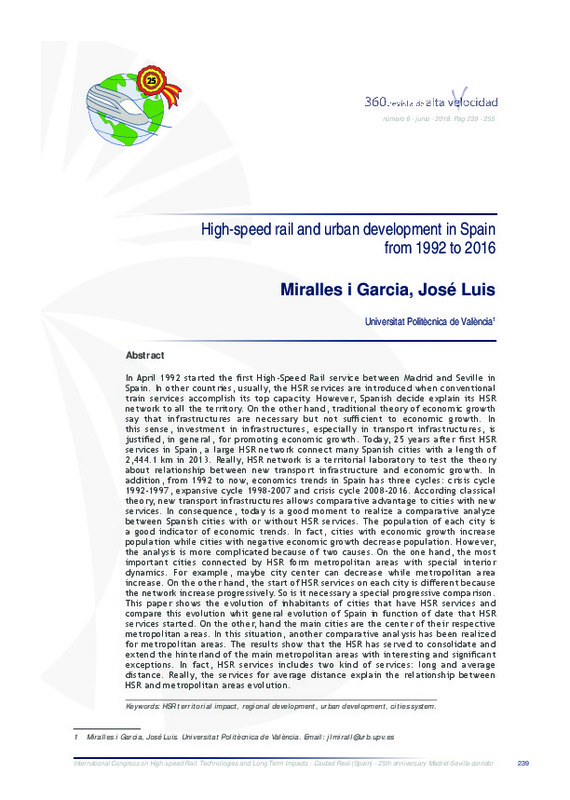JavaScript is disabled for your browser. Some features of this site may not work without it.
Buscar en RiuNet
Listar
Mi cuenta
Estadísticas
Ayuda RiuNet
Admin. UPV
High-speed rail and urban development in Spain from 1992 to 2016
Mostrar el registro sencillo del ítem
Ficheros en el ítem
| dc.contributor.author | Miralles García, José Luis
|
es_ES |
| dc.date.accessioned | 2018-09-29T04:27:33Z | |
| dc.date.available | 2018-09-29T04:27:33Z | |
| dc.date.issued | 2018 | es_ES |
| dc.identifier.uri | http://hdl.handle.net/10251/108603 | |
| dc.description.abstract | [EN] In April 1992 started the first High¿Speed Rail service between Madrid and Seville in Spain. In other countries, usually, the HSR services are introduced when conventional train services accomplish its top capacity. However, Spanish decide explain its HSR network to all the territory. On the other hand, traditional theory of economic growth say that infrastructures are necessary but not sufficient to economic growth. In this sense, investment in infrastructures, especially in transport infrastructures, is justified, in general, for promoting economic growth. Today, 25 years after first HSR services in Spain, a large HSR network connect many Spanish cities with a length of 2,444.1 km in 2013. Really, HSR network is a territorial laboratory to test the theory about relationship between new transport infrastructure and economic growth. In addition, from 1992 to now, economics trends in Spain has three cycles: crisis cycle 1992¿1997, expansive cycle 1998¿2007 and crisis cycle 2008¿2016. According classical theory, new transport infrastructures allows comparative advantage to cities with new services. In consequence, today is a good moment to realize a comparative analyze between Spanish cities with or without HSR services. The population of each city is a good indicator of economic trends. In fact, cities with economic growth increase population while cities with negative economic growth decrease population. However, the analysis is more complicated because of two causes. On the one hand, the most important cities connected by HSR form metropolitan areas with special interior dynamics. For example, maybe city center can decrease while metropolitan area increase. On the other hand, the start of HSR services on each city is different because the network increase progressively. So is it necessary a special progressive comparison. This paper shows the evolution of inhabitants of cities that have HSR services and compare this evolution whit general evolution of Spain in function of date that HSR services started. On the other, hand the main cities are the center of their respective metropolitan areas. In this situation, another comparative analysis has been realized for metropolitan areas. The results show that the HSR has served to consolidate and extend the hinterland of the main metropolitan areas with interesting and significant exceptions. In fact, HSR services includes two kind of services: long and average distance. Really, the services for average distance explain the relationship between HSR and metropolitan areas evolution. | es_ES |
| dc.language | Inglés | es_ES |
| dc.publisher | Fundación de los Ferrocarriles Españoles | es_ES |
| dc.relation.ispartof | 360. Revista de alta velocidad (online) | es_ES |
| dc.rights | Reserva de todos los derechos | es_ES |
| dc.subject | HSR territorial impacts | es_ES |
| dc.subject | Regional development | es_ES |
| dc.subject | Urban development | es_ES |
| dc.subject | Cities system | es_ES |
| dc.subject.classification | URBANISTICA Y ORDENACION DEL TERRITORIO | es_ES |
| dc.title | High-speed rail and urban development in Spain from 1992 to 2016 | es_ES |
| dc.type | Artículo | es_ES |
| dc.type | Comunicación en congreso | es_ES |
| dc.rights.accessRights | Abierto | es_ES |
| dc.contributor.affiliation | Universitat Politècnica de València. Departamento de Urbanismo - Departament d'Urbanisme | es_ES |
| dc.description.bibliographicCitation | Miralles García, JL. (2018). High-speed rail and urban development in Spain from 1992 to 2016. 360. Revista de alta velocidad (online). (6):239-255. http://hdl.handle.net/10251/108603 | es_ES |
| dc.description.accrualMethod | S | es_ES |
| dc.relation.conferencename | International Congress on High-speed Rail: Technologies and Long Term Impacts | es_ES |
| dc.relation.conferencedate | Agosto 04-Octubre 06,2017 | es_ES |
| dc.relation.conferenceplace | Ciudad Real, España | es_ES |
| dc.relation.publisherversion | http://www.tecnica-vialibre.es/360rav/ | es_ES |
| dc.description.upvformatpinicio | 239 | es_ES |
| dc.description.upvformatpfin | 255 | es_ES |
| dc.type.version | info:eu-repo/semantics/publishedVersion | es_ES |
| dc.description.issue | 6 | es_ES |
| dc.identifier.eissn | 2174-9655 | es_ES |
| dc.relation.pasarela | S\368396 | es_ES |






